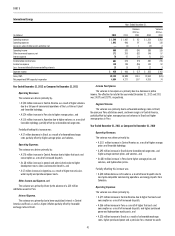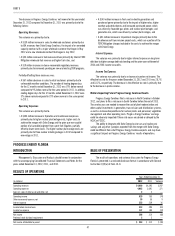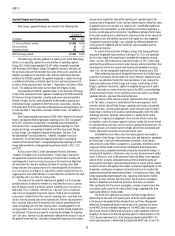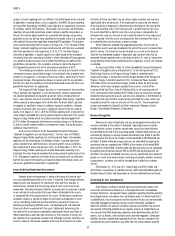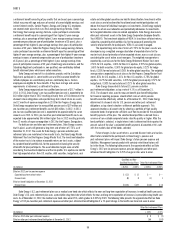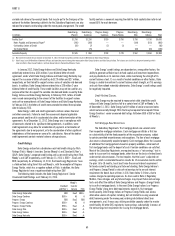Duke Energy 2012 Annual Report Download - page 71
Download and view the complete annual report
Please find page 71 of the 2012 Duke Energy annual report below. You can navigate through the pages in the report by either clicking on the pages listed below, or by using the keyword search tool below to find specific information within the annual report.
51
PART II
Operating Expenses.
The variance was primarily due to:
• A $378 million increase due to impairment and other charges recorded
in 2012 related to the Edwardsport IGCC plant that is currently under
construction of $600 million, partially offset by a 2011 Edwardsport
IGCC impairment charge of $222 million. See Note 4 to the Consolidated
Financial Statements, “Regulatory Matters,” for additional information, and
• A $102 million increase in fuel costs primarily due to an increase in fuel
rates as a result of higher fuel and purchased power costs.
Partially offsetting these increases were:
• A $29 million decrease in operation and maintenance primarily due to
higher storm costs in the prior year, and lower generation and outage
maintenance costs in 2012, partially offset by higher energy effi ciency
program costs.
Income Tax (Benefi t) Expense.
The variance in income tax expense is primarily due to a decrease in
pretax income. The effective tax rates for the years ended December 31, 2012
and 2011 were 59.5% and 30.6%, respectively. The increase in the effective
tax rate is primarily due to the decrease in pretax income in 2012 related to the
Edwardsport IGCC project.
Matters Impacting Future Duke Energy Indiana Results
On December 27, 2012, the IURC approved a settlement agreement
between Duke Energy Indiana and certain intervenors to cap the construction
costs recoverable in retail rates. The Edwardsport IGCC plant is scheduled to
begin commercial operation in mid-2013. Duke Energy Indiana’s earnings could
be adversely impacted by additional delays in the commencement of operations
which may result in increased costs.
CRITICAL ACCOUNTING POLICIES AND ESTIMATES
The application of accounting policies and estimates is an important
process that continues to develop as Duke Energy’s operations change and
accounting guidance evolves. Duke Energy has identifi ed a number of critical
accounting policies and estimates that require the use of signifi cant estimates
and judgments.
Management bases its estimates and judgments on historical experience
and on other various assumptions that it believes are reasonable at the time of
application. The estimates and judgments may change as time passes and more
information about Duke Energy’s environment becomes available. If estimates
and judgments are different than the actual amounts recorded, adjustments
are made in subsequent periods to take into consideration the new information.
Duke Energy discusses its critical accounting policies and estimates and other
signifi cant accounting policies with senior members of management and the
audit committee, as appropriate. Duke Energy’s critical accounting policies and
estimates are discussed below.
Regulatory Accounting
Duke Energy’s regulated operations (the substantial majority of U.S.
Franchised Electric and Gas’s operations) meet the criteria for application of
regulatory accounting treatment. As a result, Duke Energy records assets and
liabilities that result from the regulated ratemaking process that would not be
recorded under GAAP in the U.S. for nonregulated entities. Regulatory assets
generally represent incurred costs that have been deferred because such costs
are probable of future recovery in customer rates. Regulatory liabilities generally
represent obligations to make refunds to customers for previous collections for
costs that have yet to be incurred. Management continually assesses whether
the regulatory assets are probable of future recovery by considering factors such
as applicable regulatory environment changes, historical regulatory treatment
for similar costs in Duke Energy’s jurisdictions, litigation of rate orders,
recent rate orders to other regulated entities, and the status of any pending
or potential deregulation legislation. Based on this continual assessment,
management believes the existing regulatory assets are probable of recovery.
This assessment refl ects the current political and regulatory climate at the state
and federal levels, and is subject to change in the future. If future recovery
of costs ceases to be probable, the asset write-offs would be required to be
recognized in operating income. Additionally, the regulatory agencies can provide
fl exibility in the manner and timing of the depreciation of property, plant and
equipment, recognition of nuclear decommissioning costs and amortization of
regulatory assets or may disallow recovery of all or a portion of certain assets.
Total regulatory assets for Duke Energy were $11,741 million and $4,046 million
as of December 31, 2012 and 2011, respectively. Total regulatory liabilities
were $5,740 million and $3,006 million as of December 31, 2012 and 2011,
respectively. The increases in regulatory assets and liabilities are driven
primarily by the Progress Energy merger. For further information, see Note 4 to
the Consolidated Financial Statements, “Regulatory Matters.”
In order to apply regulatory accounting treatment and record regulatory
assets and liabilities, certain criteria must be met. In determining whether the
criteria are met for its operations, management makes signifi cant judgments,
including determining whether revenue rates for services provided to customers
are subject to approval by an independent, third-party regulator, whether the
regulated rates are designed to recover specifi c costs of providing the regulated
service, and a determination of whether, in view of the demand for the regulated
services and the level of competition, it is reasonable to assume that rates set
at levels that will recover the operations’ costs can be charged to and collected
from customers. This fi nal criterion requires consideration of anticipated
changes in levels of demand or competition, direct and indirect, during the
recovery period for any capitalized costs.
The regulatory accounting rules require recognition of a loss if it becomes
probable that part of the cost of a plant under construction or a recently
completed plant will be disallowed for ratemaking purposes and a reasonable
estimate of the amount of the disallowance can be made. Such assessments
can require signifi cant judgment by management regarding matters such as the
ultimate cost of a plant under construction, regulatory recovery implications,
etc. As discussed in Note 4, “Regulatory Matters,” during 2012, 2011 and 2010
Duke Energy Indiana recorded charges of $631 million, $222 million and
$44 million, respectively, related to the IGCC plant currently under construction
in Edwardsport, Indiana. Management will continue to assess matters as the
construction of the plant and the related regulatory proceedings continue, and
further charges could be required in 2013 or beyond. Also as discussed in
Note 2 to the Consolidated Financial Statements, “Acquisitions and Sales of
Other Assets,” Duke Energy Carolinas and Progress Energy Carolinas recorded
disallowance charges in 2012 in order to gain FERC approval of the merger
between Duke Energy and Progress Energy.
As discussed further in Note 1, “Summary of Signifi cant Accounting
Policies,” and Note 4, “Regulatory Matters,” Duke Energy Ohio discontinued
the application of regulatory accounting treatment to portions of its generation
operations in November 2011 in conjunction with the approval of its new
Electric Security Plan by the Public Utilities Commission of Ohio. The effect of
this change was immaterial to the fi nancial statements.


